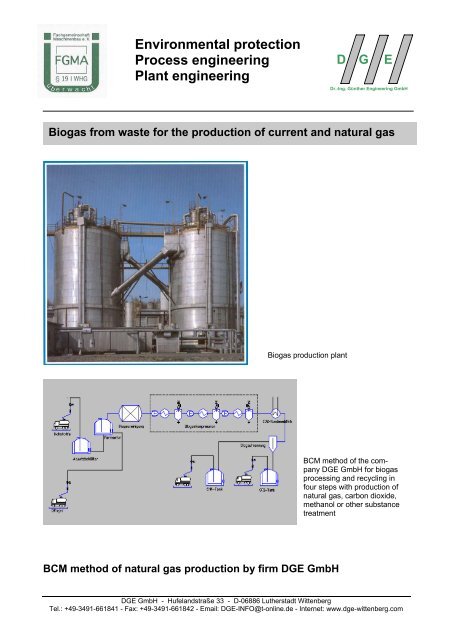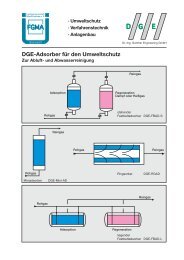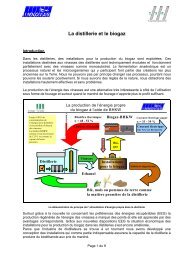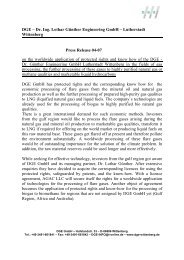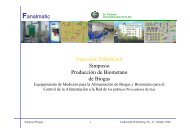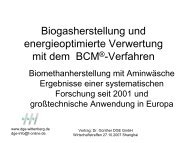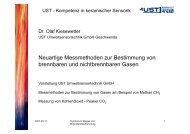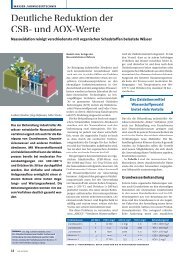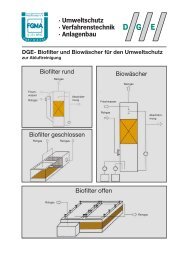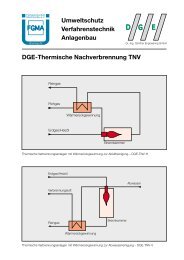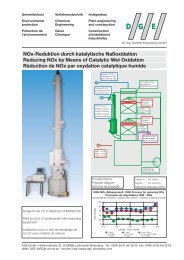Environmental protection Process engineering Plant ... - DGE GmbH
Environmental protection Process engineering Plant ... - DGE GmbH
Environmental protection Process engineering Plant ... - DGE GmbH
You also want an ePaper? Increase the reach of your titles
YUMPU automatically turns print PDFs into web optimized ePapers that Google loves.
<strong>Environmental</strong> <strong>protection</strong><br />
<strong>Process</strong> <strong>engineering</strong><br />
<strong>Plant</strong> <strong>engineering</strong><br />
D G E<br />
Dr.-Ing. Günther Engineering <strong>GmbH</strong><br />
Biogas from waste for the production of current and natural gas<br />
Biogas production plant<br />
BCM method of natural gas production by firm <strong>DGE</strong> <strong>GmbH</strong><br />
BCM method of the company<br />
<strong>DGE</strong> <strong>GmbH</strong> for biogas<br />
processing and recycling in<br />
four steps with production of<br />
natural gas, carbon dioxide,<br />
methanol or other substance<br />
treatment<br />
<strong>DGE</strong> <strong>GmbH</strong> - Hufelandstraße 33 - D-06886 Lutherstadt Wittenberg<br />
Tel.: +49-3491-661841 - Fax: +49-3491-661842 - Email: <strong>DGE</strong>-INFO@t-online.de - Internet: www.dge-wittenberg.com
Contents<br />
1. Introduction<br />
1.1 Fields of use<br />
1.2 Use of substance<br />
<strong>Environmental</strong> <strong>protection</strong><br />
<strong>Process</strong> <strong>engineering</strong><br />
<strong>Plant</strong> <strong>engineering</strong><br />
D G E<br />
Dr.-Ing. Günther Engineering <strong>GmbH</strong><br />
2. Equipment for electric power production and waste heat utilization<br />
2.1 Biogas production by using a single stage mesophyll method<br />
2.2 Biogas production by using a two-stage mesophyll method<br />
2.3 Biogas production by three-stage mesophill and thermophill method respectively<br />
3. Biogas production according to BCM-method ®<br />
3.1 Technological description of BCM-methods ®<br />
3.2 Economic evaluation of BCM-methods ®<br />
<strong>DGE</strong> <strong>GmbH</strong> - Hufelandstraße 33 - D-06886 Lutherstadt Wittenberg<br />
Tel.: +49-3491-661841 - Fax: +49-3491-661842 - Email: <strong>DGE</strong>-INFO@t-online.de - Internet: www.dge-wittenberg.com
1. Introduction<br />
<strong>Environmental</strong> <strong>protection</strong><br />
<strong>Process</strong> <strong>engineering</strong><br />
<strong>Plant</strong> <strong>engineering</strong><br />
D G E<br />
Dr.-Ing. Günther Engineering <strong>GmbH</strong><br />
The firm <strong>DGE</strong> <strong>GmbH</strong> designs and installs complete turnkey plants for biogas production and its<br />
utilization from recoverable energy.<br />
Always in accordance with an appropriate application it is possible to realize different designs.<br />
These designs include the utilization of different raw materials from agriculture, industry and communal<br />
enterprising. During all of the processes it is produced biogas which can be then utilized<br />
from the power standpoint. The possibilities of utilization are as follows:<br />
� Electric power production<br />
� Heat for long-distance heating<br />
� Natural gas as a fuel for vehicles<br />
� Natural gas for supplying gas distribution networks<br />
� Carbon dioxide, liquid carbon dioxide or in the form of solid carbon dioxide as dry<br />
ice<br />
� Production of methanol<br />
� production of soda solution<br />
� Recycling of fuel cells<br />
The technology of the <strong>DGE</strong> <strong>GmbH</strong> for the biogas recycling corresponds to the current amending of<br />
the EEG.<br />
The firm <strong>DGE</strong> <strong>GmbH</strong> is able to prepare and offer and optimum design for all field of use.<br />
The current knowledge concerning the installation and operation of facilities for the production of<br />
biogas forms a basis for any subsequent utilization of components that are contained in biogas.<br />
The available biogas resources in Germany have been estimated to amount to 12.4 up to 15.3 bil<br />
m 3 /a /1/. Despite the fact that, since 1999, the total output power of facilities for the production of<br />
biogas has tripled from 45 MW to 150 MW in the year of 2002, the current available capacity is<br />
being utilized only at around 4-5 % of the total. If we count just the possibilities for the production of<br />
methanol, which result from the difference, we find a very big number. If we go even further take<br />
into consideration the fact that 80 % of methanol in the world (the annual consumption of 28,3 million<br />
T /2/) is currently being produced from natural gas, we come to a conclusion that there is a<br />
possible replacement of this type of production with natural raw-materials.<br />
Our firm is a member of professional association Biogas e.V.<br />
1.1 Fields of use<br />
The biogas production plants are used advantageously in the following sectors:<br />
� agriculture<br />
� food industry<br />
� liquidation of municipal waste<br />
<strong>DGE</strong> <strong>GmbH</strong> - Hufelandstraße 33 - D-06886 Lutherstadt Wittenberg<br />
Tel.: +49-3491-661841 - Fax: +49-3491-661842 - Email: <strong>DGE</strong>-INFO@t-online.de - Internet: www.dge-wittenberg.com
<strong>Environmental</strong> <strong>protection</strong><br />
<strong>Process</strong> <strong>engineering</strong><br />
<strong>Plant</strong> <strong>engineering</strong><br />
D G E<br />
Dr.-Ing. Günther Engineering <strong>GmbH</strong><br />
The natural gas production represents the most economical variant the utilization of which from the<br />
power standpoint is guaranteed in all cases. When used for electric power production it is necessary<br />
to dissipate the waste heat. In summer season, however, heat is unnecessary.<br />
1.2 Use of substance<br />
The first step for the substance use is the production of natural gas quality. With the amending of<br />
the EEG in the year 2004, the conditions have been made.<br />
2. <strong>Plant</strong>s for electric power production and waste heat utilization<br />
The following examples prepared in accordance with the professional agency Increase of raw materials<br />
e.V. present a survey of possible technically feasible biogas production processes.<br />
It is possible to obtain approximate permanent values of expected economy from the survey presented<br />
in the following text.<br />
High-capacity<br />
(GVE)<br />
animal husbandry<br />
800 1.600 2.500 3.300 6.600<br />
Biogas production (m 3 /h) 50 100 150 200 400<br />
kW fuel 300 600 900 1.200 2.400<br />
Investment € 300.000 590.000 855.000 1.100.000 2.000.000<br />
The production of biogas from natural raw materials and municipal waste materials has been safely<br />
in operation for a number of years. The development in the amount of facilities for the production of<br />
biogas has been rather unsteady. As a result, thermo-/energy- utilization of biogas is due to its high<br />
calorific capacity an obvious move. All this has made it possible to produce electrical power and<br />
waste heat in electrical power plants using the biogas. The energy effectiveness of such biogas<br />
utilization is within the range of 35% at max. However, together with the utilization of waste heat, it<br />
is possible to increase the effectiveness of the conventional use of biogas in the production of electrical<br />
power up to 65 or 75 %. This rather simple reasoning indicates that if there is no arrangement<br />
for the utilization of waste heat, the cost-effectiveness of the utilization of biogas in the production<br />
of electrical power remains somewhere near the edge.<br />
<strong>DGE</strong> <strong>GmbH</strong> - Hufelandstraße 33 - D-06886 Lutherstadt Wittenberg<br />
Tel.: +49-3491-661841 - Fax: +49-3491-661842 - Email: <strong>DGE</strong>-INFO@t-online.de - Internet: www.dge-wittenberg.com
<strong>Environmental</strong> <strong>protection</strong><br />
<strong>Process</strong> <strong>engineering</strong><br />
<strong>Plant</strong> <strong>engineering</strong><br />
2.1 Biogas production by using a single stage mesophyll method<br />
D G E<br />
Dr.-Ing. Günther Engineering <strong>GmbH</strong><br />
The single-stage mesophyll wet fermentation method is suitable above all for small agricultural<br />
enterprises in which there is at disposal all the time stable manure resulting from cattle breeding or<br />
pig breeding.<br />
At using this method it is possible at the same time to process an insignificant quantity, i.e. an amount<br />
of 5-10% of processed substrate to manure or silage. Always according to the equipment<br />
size it is possible to install more single-stage fermenters either in series or in parallel.<br />
The produced head is utilized on the fermenter and for heating buildings. The produced electric<br />
power is consumed partially for operation of the plant. The surplus electric power is supplied in the<br />
mains.<br />
The method can be combined with BCM-method and instead of electric power it is possible to produce<br />
natural gas and carbon dioxide.<br />
Biologcal w aste<br />
Waste heat<br />
Manure<br />
Fermenter<br />
Service-remote maintenance<br />
Gas purification<br />
BHKW<br />
Residue<br />
Gas storage<br />
Fertilizer<br />
electrical pow er<br />
<strong>DGE</strong> <strong>GmbH</strong> - Hufelandstraße 33 - D-06886 Lutherstadt Wittenberg<br />
Tel.: +49-3491-661841 - Fax: +49-3491-661842 - Email: <strong>DGE</strong>-INFO@t-online.de - Internet: www.dge-wittenberg.com
<strong>Environmental</strong> <strong>protection</strong><br />
<strong>Process</strong> <strong>engineering</strong><br />
<strong>Plant</strong> <strong>engineering</strong><br />
2.2 Biogas production by two-stage mesophill method<br />
D G E<br />
Dr.-Ing. Günther Engineering <strong>GmbH</strong><br />
The two-stage mesophill method of wet fermentation is suitable particularly for combined treatment<br />
of stable manure and natural raw materials. In this method the portion of natural materials may be<br />
up to 50 %. Always according to capacity of the equipment it is possible to install in parallel more<br />
single-stage fermenters.<br />
The produced heat is utilized in the fermenter and for heating buildings. The produced electric power<br />
is partially consumed for operation of the equipment. The surplus electric power is supplied<br />
into the mains.<br />
The method can be combined with BCM-method and instead of electric power it is possible to produce<br />
natural gas and carbon dioxide.<br />
Sila ge<br />
Biological w aste<br />
Kato ffelp ülpe<br />
Waste heat<br />
Manure<br />
Fermenter 1<br />
Service-remote maintenance<br />
Fermenter 2<br />
BHKW<br />
Gas<br />
purification<br />
Residue<br />
Gas storage<br />
Fertilizer<br />
electrical pow e<br />
<strong>DGE</strong> <strong>GmbH</strong> - Hufelandstraße 33 - D-06886 Lutherstadt Wittenberg<br />
Tel.: +49-3491-661841 - Fax: +49-3491-661842 - Email: <strong>DGE</strong>-INFO@t-online.de - Internet: www.dge-wittenberg.com
<strong>Environmental</strong> <strong>protection</strong><br />
<strong>Process</strong> <strong>engineering</strong><br />
<strong>Plant</strong> <strong>engineering</strong><br />
D G E<br />
Dr.-Ing. Günther Engineering <strong>GmbH</strong><br />
2.3 Biogas production by three-stage mesophill and thermophill method respectively<br />
With the use three-stage method it is possible in combination of mesophill and thermophill wet fermentation<br />
process to process markedly higher quantity of natural raw materials. In the framework<br />
of this method the portion of natural raw materials and biological waste may be up to 90 to 100 %.<br />
Always in accordance with the capacity of the equipment it is possible to connect in parallel more<br />
single-stage fermenters.<br />
The produced heat is utilized in the fermenter and for heating buildings. The produced electric power<br />
is partially consumed for operation of the equipment. The surplus electric power is supplied<br />
into the mains.<br />
The method can be combined with BCM-method and instead of electric power it is possible to produce<br />
natural gas and carbon dioxide.<br />
Pit 1<br />
Pit 2<br />
Pit 3<br />
Pumpenverteiler<br />
Fermenter 1 Fermenter 2<br />
mesophil thermophil<br />
Service-remote maintenanc<br />
Fermenter 3<br />
BHKW<br />
Gas<br />
purification<br />
Gas storage<br />
electrical pow er<br />
<strong>DGE</strong> <strong>GmbH</strong> - Hufelandstraße 33 - D-06886 Lutherstadt Wittenberg<br />
Tel.: +49-3491-661841 - Fax: +49-3491-661842 - Email: <strong>DGE</strong>-INFO@t-online.de - Internet: www.dge-wittenberg.com
<strong>Environmental</strong> <strong>protection</strong><br />
<strong>Process</strong> <strong>engineering</strong><br />
<strong>Plant</strong> <strong>engineering</strong><br />
3. Biogas production according to BCM method ®<br />
D G E<br />
Dr.-Ing. Günther Engineering <strong>GmbH</strong><br />
The biogas production has been introduced successfully from the beginning of 1970 after the oil<br />
crisis. Legislative in 1990 and 2000 for “recoverable energy” has been a cause in the last years of<br />
a marked increase of the rate of growth of the number of biogas production plants. The number of<br />
the biogas production plants in Germany in 2003 was more than ten times higher when compared<br />
to that number of biogas production plants in 1990.<br />
The produced biogas is utilized above all for electric power production and for revaluation of waste<br />
heat. As a higher degree of utilization of biogas consists in feeding natural gas distribution networks<br />
or using the biogas as a fuel of vehicles and eventually its use as a synthesis gas. It was<br />
realized successfully and several plants of this type were put into operation in Scandinavia.<br />
In several countries as for example in England or United States quota system does exist for sale of<br />
electric power produced from biogas. If a sufficient quota is attained, then consumption is taken in<br />
consideration and the biogas production plant must be put out of operation to be in standstill condition.<br />
From /3/ it is possible to estimate attained biogas flow-rates for m³ or t.<br />
Cow stable 200 m³ Methane/ t oTS 20 m³ of biogas/m³<br />
manure<br />
Pig stable 300 m³ Methane/ t oTS 30 m³ of biogas/m³<br />
manure<br />
Poultry<br />
nurema-<br />
250 m³ Methane/ t oTS 40 m³ of biogas/m³<br />
Sludge 300 m³ Methane/ t oTS 5 m³ of biogas/m³<br />
Biowaste 250 m³ Methane/ t oTS 100 m³ of biogas/m³<br />
Fat 720 m³ Methane/ t oTS 650 m³ of biogas/m³<br />
Gas 480 m³ Methane/ t oTS 125 m³ of biogas/m³<br />
Biogas composition<br />
Components formula vol.%<br />
Methane CH4 40-75<br />
Carbon dioxide CO2 25-55<br />
Water vapour H2O 0-10<br />
Nitrogen N2 0-5<br />
Oxygen O2 0-2<br />
Hydrogen H2 0-1<br />
Ammonia NH3 0-1<br />
Hydrogen sulphide H2S 0-1<br />
High capacity fermentation plants with a<br />
gas storage tank<br />
In accordance with these data it is possible using a biogas production plant with a middle capacity<br />
at treating cow stable manure in an amount of 10 m³/h to produce an amount of 200 m³/h of biogas.<br />
Modern equipments have been designed in such a way that in the fermentation part it is possible<br />
at the same time to increase the value of different kinds of biomass. It is possible then utilize<br />
the fermented substrate as a manure.<br />
As the most usual method of increasing the value of biogas is considered to be in the present time<br />
the use of biogas for electric power production. In this case, however, it is attained a lower power<br />
efficiency for the reason of a relatively high CO2 portion in biogas. When utilizing biogas very often<br />
<strong>DGE</strong> <strong>GmbH</strong> - Hufelandstraße 33 - D-06886 Lutherstadt Wittenberg<br />
Tel.: +49-3491-661841 - Fax: +49-3491-661842 - Email: <strong>DGE</strong>-INFO@t-online.de - Internet: www.dge-wittenberg.com
<strong>Environmental</strong> <strong>protection</strong><br />
<strong>Process</strong> <strong>engineering</strong><br />
<strong>Plant</strong> <strong>engineering</strong><br />
D G E<br />
Dr.-Ing. Günther Engineering <strong>GmbH</strong><br />
also other components of the biogas are as disturbing components as for example ammonia and<br />
hydrogen sulphide.<br />
Therefore, the technological development carried out by the firm <strong>DGE</strong> <strong>GmbH</strong> is aimed at a marked<br />
increase of economy and flexibility when increasing the value of biogas. At the same time it must<br />
be enabled above all the industrial increase of the value of biogas products.<br />
In summer season the heat consumption is negligible or that heat consumption is zero. This fact<br />
represents often an insufficiency when utilizing biogas for electric power production.<br />
Investigations /4/ carried out have shown that the existing methods of production and treatment of<br />
biogas are too expensive:<br />
High-capacity<br />
(GVE)<br />
animal husbandry<br />
800 1.600 2.500 3.300 6.600<br />
Biogas production (m 3 /h) 50 100 150 200 400<br />
kW fuel 300 600 900 1.200 2.400<br />
Investment € 300.000 590.000 855.000 1.100.000 2.000.000<br />
Capital costs 30.889 60.748 88.033 113.259 205.926<br />
Personnel 17.000 30.000 43.000 53.000 70.000<br />
W+R+various 10.500 20.650 29.925 38.500 70.000<br />
Costs per year 58.389 111.398 160.958 204.759 345.926<br />
Annual production (MWh) 2.400 4.800 7.200 9.600 19.200<br />
Gas purchase costs (Biogas) (€/MWh) 24 23 22 21 18<br />
Production costs (ct/kWh) 2,4 2,3 2,2 2,1 1,8<br />
Bioplant proper heat consumption<br />
(kW) 96 182 259<br />
326 576<br />
(MWh) 480 912 1.296 1.632 2.880<br />
Costs and proper heat consumption of agricultural high-capacity animal husbandry<br />
Biogas production (m 3 /h) 50 100 150 200 400<br />
Production (ct/kWh)<br />
Conversion to natural gas quality<br />
2,4 2,3 2,2 2,1 1,8<br />
(ct/kWh) from<br />
1,6<br />
to 3,5 2,7 2,5 2,2<br />
probably 2,6 1,8 1,3 1,2 0,8<br />
Necessary output (ct/kWh) 5,0 4,1 3,5 3,3 2,6<br />
Purchase cost of biogas produced in a comparable quality with that of natural gas<br />
With the use BCM method ® by the firm <strong>DGE</strong> <strong>GmbH</strong> we are presenting now an economic technology<br />
by means of which the biogas is produced in such a way that it can be utilized as synthesis<br />
gas. The separated carbon dioxide reaches in this case even food quality. In this time it is in<br />
course necessary technological development.<br />
<strong>DGE</strong> <strong>GmbH</strong> - Hufelandstraße 33 - D-06886 Lutherstadt Wittenberg<br />
Tel.: +49-3491-661841 - Fax: +49-3491-661842 - Email: <strong>DGE</strong>-INFO@t-online.de - Internet: www.dge-wittenberg.com<br />
1,4<br />
0,9<br />
0,7
<strong>Environmental</strong> <strong>protection</strong><br />
<strong>Process</strong> <strong>engineering</strong><br />
<strong>Plant</strong> <strong>engineering</strong><br />
3.1 Technological description of BCM-methods ®<br />
D G E<br />
Dr.-Ing. Günther Engineering <strong>GmbH</strong><br />
Biogas contains valuable raw-components. This invites the option of substance-utilization of these<br />
raw-components, since these can be processed independently of the utilization process of waste<br />
heat. The cleaning of biogas in order to remove NH3, H2S and exsiccation is a tried-and-true<br />
method and has already been in use. Its implementation is a prerequisite for substance-utilization<br />
of main components CH4 and CO2 which are contained in biogas. The <strong>DGE</strong> <strong>GmbH</strong> Company has<br />
developed four different cleaning and modification techniques for different available options of substance-utilization<br />
of biogas – ref. to the following shortened versions of descriptions.<br />
3.1.1 Means of biogas utilization BCM-0<br />
Natural gas production<br />
The basic method for the production of natural gas is the split-up of biogas into natural gas and<br />
carbon dioxide. As a result of a newly enacted Law of Renewable Energy Resources (EEG), the<br />
utilization of this method itself brings considerable advantages to everyone who operates a facility<br />
based on biogas, where this biogas is used to produce electrical power.<br />
3.1.2 Means of biogas utilization BCM-1<br />
Soda and natural gas production<br />
Biogas that comes out of a container is always cleaned first, using one washer; forming NH3 and<br />
H2S, and having been modified in this way, the biogas is further taken into the waste-gas washer,<br />
in which CO2 and NaOH are removed for the purpose of producing Na2CO3.<br />
Subsequently, with the use of a compressor, the cleaned-up biogas is compressed like a natural<br />
gas to reach the desired pressure. Following the first compression phase, gas dehydration is prescribed,<br />
along with the so-called “police filter”.<br />
The achieved quality of the natural gas is somewhere in the neighborhood of 98 vol. % CH4 and<br />
2 vol. % CO2.<br />
3.1.3 Means of biogas utilization BCM-2<br />
Compressive condensation in the production of split mixtures CO2/CH4<br />
Biogas that comes out of a container is always cleaned first, using one washer; forming NH3 and<br />
H2S, and having been modified in this way, the biogas is further taken into a compression device.<br />
The following condensation phase gives rise to the forming of a gas rich on methane, which is of<br />
the same quality as natural gas, and carbon dioxide saturated with methane is being obtained, as<br />
well.<br />
Following the first compression phase, gas dehydration is prescribed, along with the so-called “police<br />
filter”.<br />
The cleaned-up gas, just like natural gas (high-caloric gas), may be supplied into the (distribution)<br />
system or be used as fuel. The carbon dioxide (classified as low-caloric gas), which is obtained in<br />
<strong>DGE</strong> <strong>GmbH</strong> - Hufelandstraße 33 - D-06886 Lutherstadt Wittenberg<br />
Tel.: +49-3491-661841 - Fax: +49-3491-661842 - Email: <strong>DGE</strong>-INFO@t-online.de - Internet: www.dge-wittenberg.com
<strong>Environmental</strong> <strong>protection</strong><br />
<strong>Process</strong> <strong>engineering</strong><br />
<strong>Plant</strong> <strong>engineering</strong><br />
D G E<br />
Dr.-Ing. Günther Engineering <strong>GmbH</strong><br />
a liquid-state, may be used after its expansion in an electrical power plant in the production of electric<br />
power. The temperature of – 50°C is a condensation temperature at which methanol and carbon<br />
dioxide become disintegrated to form 1 kmol/h of biogas:<br />
Gaseous phase gas in liquid state Total<br />
rich gas poor gas<br />
Methane 0,385 0,275 0,66<br />
Carbon dioxide 0,06 0,27 0,33<br />
In addition, both parts are separately used to produce products such as methanol, hydrogen, or<br />
other hydrocarbons, using the “Fischer Tropsch Synthese“. It is possible to produce up to 70 1/h of<br />
methanol from 100 m³/h of biogas.<br />
3.1.4 Means of biogas utilization BCM-3<br />
Compressive washing for the production of carbon dioxide and natural gas<br />
Biogas that comes out of a container is always cleaned first, using one washer; forming NH3 and<br />
H2S, and having been modified in this way, the biogas is further taken into a compressor. The<br />
compressed gas must be washed either after the first or the second compression stage, depending<br />
on the type of the washing medium used. The washing procedure of the compressed gas is when<br />
the biogas gets rid of CO2 up to less than 1 vol. %, and in this condition, it may be supplied into the<br />
natural gas distribution system. The required compression phase, as well as exsiccation that might<br />
be possibly needed, must be adjusted to the current conditions.<br />
Carbon dioxide, which has been removed from the washing solution, is of high cleanness and may<br />
be liquefied after it is submitted to another compression phase. The achieved quality of the natural<br />
gas is higher than 99 vol. % CH4 and less than 1 vol. % CO2. It is technically possible to reduce the<br />
amount of CO2 below 10 ppm.<br />
The thus produced carbon dioxide can be easily modified to achieve the quality commonly used in<br />
the food industry. There are, however, many ways of how the technically-clean carbon dioxide can<br />
be used, ranging from dry ice, through its applicability in fire extinguishers, to material tests or its<br />
use in coolants.<br />
3.1.5 Means of biogas utilization BCM-4<br />
Absorption caused by a change in pressure for the production of carbon dioxide and natural<br />
gas<br />
Using a compressor, the previously cleaned biogas is compressed to the desired pressure of the<br />
natural gas from 12 to 20 bars and subsequently is brought to absorption by a change in pressure.<br />
The absorption, which is caused by the change in pressure, is preceded by desiccation using silica<br />
gel. The absorption, brought about by a pressure change, is composed of four absorbers, two of<br />
which are always absorption-active, one of the remaining absorbers is activated for the release and<br />
regressive conveyance of biogas, and the last of the absorbers serves for the separation of CO2.<br />
This ensures that the absorption, along with a pressure change, yields the production of the same<br />
product CH4 a CO2 over time. Special molecular sieves are used for the absorption.<br />
<strong>DGE</strong> <strong>GmbH</strong> - Hufelandstraße 33 - D-06886 Lutherstadt Wittenberg<br />
Tel.: +49-3491-661841 - Fax: +49-3491-661842 - Email: <strong>DGE</strong>-INFO@t-online.de - Internet: www.dge-wittenberg.com
<strong>Environmental</strong> <strong>protection</strong><br />
<strong>Process</strong> <strong>engineering</strong><br />
<strong>Plant</strong> <strong>engineering</strong><br />
3.2 Economic evaluation of BCM-methods ®<br />
3.2.1 Method BCM-0<br />
D G E<br />
Dr.-Ing. Günther Engineering <strong>GmbH</strong><br />
With the use of this basic method, biogas may be easily modified and divided into natural gas and<br />
CO2. Here, there is no substance-utilization of CO2. The thus produced natural gas is effectively<br />
used to produce electrical power. This method is cost-effective for devices/equipment at 100 Nm 3 /h<br />
or smaller amounts of biogas.<br />
3.2.2 Method BCM-1<br />
Biogas cleaning is carried out with good reliability, even up to the quality of natural gas. The<br />
method of production of brine from concentrated waste gas CO2 is one of commonly tried, verified,<br />
and used methods, and an example of a company using this method is Bayer Co.<br />
This method is cost-effective starting at an amount of 300 Nm 3 /h of biogas.<br />
The cost-effectiveness is highly dependent on the selling price of soda. There are many ways of<br />
utilization of the produced soda, e.g. in glass industry. Due to the fact that this method calls for<br />
additional personnel, two new employees have been hired per shift, i.e. a total of 6 employees per<br />
day. Wage expenses must be adjusted to the current situation. Shall there be a long-lasting demand<br />
for the produced soda to be sold at good prices; this would surely be an interesting alternative.<br />
For the purpose of utilization in the production of electrical power, the evaluation included a<br />
bonus or premium of 0.02 €/KWh of natural gas.<br />
3.2.3 Method BCM-2<br />
There is a need to consider restrictions concerning the relatively high amount of CO2 after condensation,<br />
when looking at the biogas cleaning process and the quality of natural gas. In case a bonus<br />
or premium of 0,02 €/KWh is also obtained for biogas cleaning, then this method could also be<br />
very interesting.<br />
Shall the acquired high-caloric gas be used for the production of methanol instead of electricity,<br />
this method will yield a quick return on investment for even small devices and appliances.<br />
With the use of compressive condensation, it is possible for the purpose of further substanceutilization<br />
in Fischer Tropsch Synthese to produce fractions of desired configuration.<br />
3.2.4 Method BCM-3<br />
Biogas cleaning with the use of compressive washing and retrogressive acquisition of carbon dioxide<br />
is cost-effective for appliances or facilities starting at amounts of 200 Nm³/h of biogas.<br />
Shall the produced natural gas be used for the production of methanol instead of electricity; the<br />
cost-effectiveness is given for amounts starting at 200 Nm³/h of biogas. If we take into account<br />
expenses incurred to purchase the desired equipment/facility for methanol, the return on invest-<br />
<strong>DGE</strong> <strong>GmbH</strong> - Hufelandstraße 33 - D-06886 Lutherstadt Wittenberg<br />
Tel.: +49-3491-661841 - Fax: +49-3491-661842 - Email: <strong>DGE</strong>-INFO@t-online.de - Internet: www.dge-wittenberg.com
<strong>Environmental</strong> <strong>protection</strong><br />
<strong>Process</strong> <strong>engineering</strong><br />
<strong>Plant</strong> <strong>engineering</strong><br />
D G E<br />
Dr.-Ing. Günther Engineering <strong>GmbH</strong><br />
ment shall be more than five years from now. Since there is a big market for methanol, the longterm<br />
sales are secured.<br />
3.2.5 Method BCM-4<br />
The biogas cleaning process that employs absorption and change in pressure is economically feasible<br />
even for small devices with the amount of biogas equal to 100 m³/h.<br />
Natural gas and carbon dioxide are of high quality. The advantage of this process is that it is not<br />
necessary to use any chemical additives as opposed to compressive washing machines.<br />
3.2.5 Summary<br />
The four different biogas-cleaning methods described above may be implemented, depending on<br />
the given utilization. Nowadays, it is without a doubt that the technically easiest option is method<br />
BCM 0. The highest possible effectiveness can be achieved only together with some equipment for<br />
retrogressive acquisition of carbon dioxide or equipment for the production of soda according to<br />
methods BCM-1 and BCM-3. The BCM-4 process is advantageous especially when there is a need<br />
for the direct distribution of natural gas, since the natural gas is of sufficient overpressure to be fed<br />
into the distribution system. The production of methanol should be worthy of consideration in a few<br />
years, after the rise of prices of natural gas.<br />
<strong>DGE</strong> <strong>GmbH</strong> - Hufelandstraße 33 - D-06886 Lutherstadt Wittenberg<br />
Tel.: +49-3491-661841 - Fax: +49-3491-661842 - Email: <strong>DGE</strong>-INFO@t-online.de - Internet: www.dge-wittenberg.com
Sources:<br />
<strong>Environmental</strong> <strong>protection</strong><br />
<strong>Process</strong> <strong>engineering</strong><br />
<strong>Plant</strong> <strong>engineering</strong><br />
/1/ Biogasgewinnung und –nutzung<br />
Institut für Energetik und Umwelt <strong>GmbH</strong><br />
Torgauer Straß3 116<br />
04347 Leipzig<br />
/2/ Schweizer Zentrum für Ökoinventare<br />
20.Diskussionsforum Ökobilanzen<br />
19. September 2003 ETH Zürich<br />
/3/ FH Bochum Solar Netz, December 2001<br />
D G E<br />
Dr.-Ing. Günther Engineering <strong>GmbH</strong><br />
/4/ Bremer Energie Institut<br />
Untersuchung zur Aufbereitung von Biogas zur Erweiterung von Nutzungsmöglichkeiten<br />
June 2003<br />
Enclosures<br />
1-1 Drawing of method BCM 0<br />
1-2 Drawing of method BCM 1<br />
1-3 Drawing of method BCM 2<br />
1-4 Drawing of method BCM 3<br />
1-5 Drawing of method BCM 4<br />
2-1 Diagram process of biogas treatment – natural gas with substance use<br />
2-2 Diagram process of biogas treatment – profitability calculation of methods<br />
2-3 Diagram process of biogas treatment – calculated amortisation of methods<br />
3 Why biogas?<br />
4 Questionnaire<br />
<strong>DGE</strong> <strong>GmbH</strong> - Hufelandstraße 33 - D-06886 Lutherstadt Wittenberg<br />
Tel.: +49-3491-661841 - Fax: +49-3491-661842 - Email: <strong>DGE</strong>-INFO@t-online.de - Internet: www.dge-wittenberg.com
Biogas<br />
NH3scrubbing<br />
H2SO4 Na2CO3<br />
Fertilizer<br />
H2Sscrubbing<br />
Biogas purification process BCM 0<br />
Basic variant for natural gas quality<br />
Absorber<br />
H2O2<br />
Stripper<br />
Police filter<br />
Steam<br />
natural gas<br />
CH4 > 98 Vol.%<br />
CO2 < 1 Vol.%<br />
carbon dioxyde<br />
CO2 > 99,5 Vol.%<br />
App. 1-1
Biogas<br />
NH3scrubbing<br />
H2SO4 Na2CO3<br />
Fertilizer<br />
CO2scrubbingH2Sscrubbing<br />
H2O2<br />
Centrifuge<br />
Soda<br />
Biogas purification process BCM 1<br />
with production of soda<br />
NaOH 50 %<br />
Dehumidification Police filter<br />
Compactor 1. stage<br />
natural gas<br />
Compactor 2. stage<br />
App. 1-2
Biogas<br />
NH3scrubbing<br />
H2SO4 Na2CO3<br />
Fertilizer<br />
H2Sscrubbing<br />
Biogas purification process BCM 2<br />
with pressure condensation<br />
Dehumidification Police filter<br />
Compactor 1. stage<br />
H2O2<br />
natural gas<br />
rich gas<br />
CH4 78 Vol.%<br />
CO2 19 Vol.%<br />
Compactor 2. stage Compactor 3. stage<br />
poor gas<br />
CH4 43 Vol.%<br />
CO2 57 Vol.%<br />
Condensor<br />
App. 1-3
Biogas<br />
NH3scrubbing<br />
H2SO4 Na2CO3<br />
Fertilizer<br />
H2Sscrubbing<br />
Absorber<br />
Compactor 1. stage<br />
H2O2<br />
Biogas purification process BCM 3<br />
with production of carbon dioxide and natural gas<br />
Stripper<br />
Polizeifilter<br />
Compactor 2. stage<br />
Steam<br />
Compactor 3. stage<br />
Condensor<br />
Carbon dioxyde<br />
CO2 > 99,5 Vol.%<br />
natural gas<br />
CH4 > 98 Vol.%<br />
CO2 < 1 Vol.%<br />
Compactor 2. stage Compactor 3. stage<br />
App. 1-4
Biogas<br />
NH3scrubbing<br />
H2SO4 Na2CO3<br />
Fertilizer<br />
H2Sscrubbing<br />
Compactor<br />
1.Stage<br />
H2O2<br />
Deshumidification<br />
Silicagel<br />
Compactor<br />
2.Stage<br />
Biogas purification process BCM 4 with production<br />
of carbon dioxide and natural gas<br />
Pressure change adsorption<br />
natural gas<br />
CH4 > 98 Vol.%<br />
CO2 < 1 Vol.%<br />
carbon dioxide<br />
CO2 > 99,5 Vol.%<br />
App. 1-5
<strong>DGE</strong>-Project: 0319-1401-0 Biogas treatment Issue 01: 10.07.2004<br />
Return time in years<br />
80<br />
70<br />
60<br />
50<br />
40<br />
30<br />
20<br />
10<br />
0<br />
<strong>DGE</strong>-process for biogas treatment<br />
calculated amortisation of the process<br />
100 200 300 400 500 600 700 800 900 1000<br />
Biogas flow in Nm³/h<br />
BCM-0 BCM-1<br />
BCM-2 BCM-3<br />
BCM-4<br />
without CO 2-Emission trade App. 2-3
<strong>DGE</strong>-Project: 0319-1401-0 Biogas treatment Issue 01: 10.07.2004<br />
Investment in 1.000 €<br />
900<br />
800<br />
700<br />
600<br />
500<br />
400<br />
300<br />
200<br />
100<br />
0<br />
<strong>DGE</strong>-process for biogas treatment<br />
natural gas with substance use<br />
100 200 300 400 500 600 700 800 900 1000<br />
Biogas flow in Nm³/h<br />
BCM-0 BCM-1<br />
BCM-2 BCM-3<br />
BCM-4<br />
App. 2-1
<strong>DGE</strong>-Project: 0319-1401-0 Biogas treatment Issue 01: 10.07.2004<br />
Profit/loss per year in 1.000 €<br />
700<br />
600<br />
500<br />
400<br />
300<br />
200<br />
100<br />
0<br />
-100<br />
-200<br />
<strong>DGE</strong>-process for biogas treatment<br />
profitability calculation of the processes<br />
100 200 300 400 500 600 700 800 900 1000<br />
Biogas flow in Nm³/h<br />
BCM-0 BCM-1<br />
BCM-2 BCM-3<br />
BCM-4<br />
without CO 2-Emission trade App. 2-2
Why biogas?<br />
App. 3<br />
Nobody can tell exactly how large are the reserves that fossil energy bearers hold in store,<br />
and nobody can predict how these reserves will be consumed over time in the future. After<br />
all, it is entirely up to us, whether we consume a lot of energy or a little. The prospects, however,<br />
are such that the world consumption will be rising rather than falling. Enhanced industrialization<br />
is under way particularly in Asia and South America.<br />
It is possible to easily predict the statistical outlook for the reserves, well known to us. At the<br />
current rate of consumption, we must count on running out of petroleum and natural gas<br />
within the course of the next 40 to 50 years. Although there are reserves available for another<br />
extra 10 years, the problem remains the same. Shall the rate of consumption keep on<br />
rising, the reserves could be depleted earlier than expected. The supplies of petroleum are<br />
being reduced long before they are expected to be used up. The process of extracting petroleum<br />
will be getting more difficult and more expensive as well. That, in turn, will lead to a<br />
substantial increase in prices, and under certain circumstances, even to fights over how the<br />
reserves will be divided.<br />
Since there is still a lot of time available for the implementation of a change in the energysupply<br />
structure, it is the right time to consider the possible alternatives.<br />
The graphical representation of the statistical outlook for petroleum, gas and coal. (1994)<br />
Source: www.hyweb.de
Questionnaire for clients in agriculture and industry<br />
For biogas equipment conception<br />
Send please the completed questionnaire back to the following address:<br />
<strong>DGE</strong> <strong>GmbH</strong><br />
Hufelandstr. 33<br />
06886 Wittenberg<br />
D G E<br />
Dr.-Ing. Günther Engineering <strong>GmbH</strong><br />
Fax: 03491-661842<br />
_____________________________________________________________________________________________________<br />
1. Address<br />
Firm: _________________________________________________________________<br />
Contact person: _________________________________________________________________<br />
Street: _________________________________________________________________<br />
Organization number<br />
Postcode, place _________________________________________________________________<br />
Telephone, Fax: _________________________________________________________________<br />
2. Power situation<br />
2.1 Electric power consumption<br />
Proper electric power consumption kW / year<br />
Cost of electric current<br />
Mode of statement of cost<br />
(electric supply meter, 96 hours electricity<br />
meter, high/low rate)<br />
Name of power supplier<br />
Existing power supply<br />
(middle, low voltage etc.)<br />
EUR /year<br />
Distance to the nearest transformer and<br />
transformer power<br />
m kW<br />
2.2 Heat consumption<br />
Has to be connected the proper buildings to biogas heat?<br />
□ Yes<br />
Number of residential houses □ 1 □ 2 □ 3 □ stable/cowshed □ operating building<br />
The present fuel kind Heat consumption in<br />
summer<br />
(April – September)<br />
Heat consumption in<br />
winter<br />
(October - March)<br />
Approximate yearly<br />
cost<br />
EUR<br />
EUR<br />
You can state your consumption above all in kWh or also in liters (heating oil) or eventually in cubic meters (natural gas).<br />
□ Not<br />
Are there in your neighbourhood eventual heat consumers?<br />
For example garden centres, drying equipments, schools, hospitals, an existing network of longdistance<br />
heat supply etc.<br />
App. 4
Type of heat<br />
consumer<br />
2.3 Natural gas consumption<br />
Heat consumption in<br />
summer<br />
(April – September)<br />
Heat consumption in<br />
winter<br />
(October - March)<br />
Distance<br />
Natural gas proper consumption kW /year<br />
Cost of natural gas EUR/year<br />
Mode of statement of cost<br />
Name of power supplier<br />
Are there in your neighbourhood eventual natural gas consumers?<br />
For example industrial plants etc.<br />
Type of heat<br />
consumer<br />
Heat consumption in<br />
summer<br />
(April – September)<br />
2.4 Consumption of natural gas for vehicles<br />
Heat consumption in<br />
winter<br />
(October - March)<br />
Distance<br />
Natural gas proper consumption KW /year<br />
Cost of natural gas EUR /year<br />
2.5 Carbon dioxide consumption<br />
Carbon dioxide consumption kW /year<br />
Cost of carbon dioxide EUR /year<br />
3. Amount of cattle<br />
Kind of animals (precisely if<br />
possible please)<br />
Heifers<br />
Number<br />
of heads<br />
of cattle /<br />
places<br />
Cattle unit Mode of<br />
location<br />
In case of free breeding specify please number of days, mode of location.<br />
Straw litter: □ Yes ______ hectare/year<br />
______ quintal/year<br />
□ Not<br />
4. Cofermentation<br />
Liquid manure<br />
quantity<br />
Does exist a prospect of cofermentation of additional waste:<br />
For example: scraps, vegetables waste, slaughterhouse waste or dairy waste, meal waste, oils, fats,<br />
etc.?<br />
□ Yes (complete please the following table) □ Not<br />
m<br />
m<br />
m<br />
m<br />
App. 4
Kind of waste Period Quantity a<br />
year<br />
5. Further completing data<br />
Origin Price/t<br />
from<br />
farmstead<br />
� Connection to canalization □ exists □ is planned □ none of the two variants<br />
� Existing capacity for storing liquid manure _______________________ m³<br />
� Area utilized for agriculture in total _______________________hectare<br />
� Which amount of area taken away is at disposal<br />
hired _______________________ hectare<br />
at the present time? _______________________ hectare<br />
� How many hectares would be at disposal<br />
for growing of growing up raw materials<br />
(voluntary taking away) _______________________ hectare<br />
� I am interesting in full financing the equipment □ yes □ not<br />
App. 4


